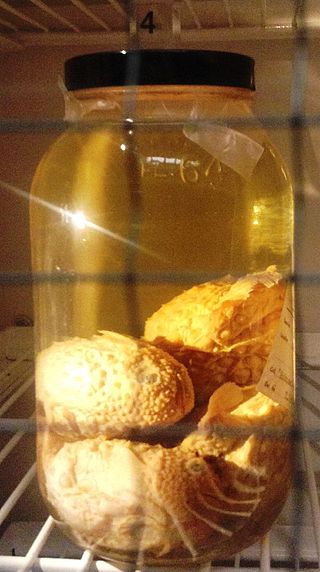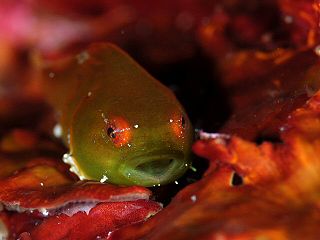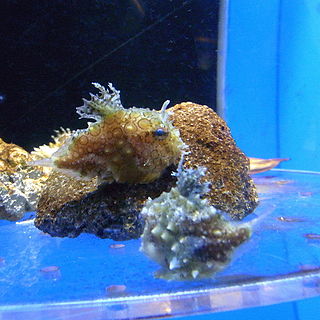
The Cyclopteridae are a family of marine fishes, commonly known as lumpsuckers or lumpfish, in the order Scorpaeniformes. They are found in the cold waters of the Arctic, North Atlantic, and North Pacific oceans. The greatest number of species are found in the North Pacific. The family name Cyclopteridae derives from the Greek words κύκλος (kyklos), meaning "circle", and πτέρυξ (pteryx), meaning "wing" or "fin", in reference to the circle-shaped pectoral fins of most of the fish in this family.

Cyclopterus is a genus of marine ray-finned fish belonging to the family Cyclopteridae, the lumpsuckers or lumpfish. Its only species is Cyclopterus lumpus, the lumpsucker or lumpfish. It is found in the North Atlantic and adjacent parts of the Arctic Ocean, ranging as far south as Chesapeake Bay on the North American coast and Spain on the European coast. The species has been reported twice in the Mediterranean Sea, off Croatia in 2004 and Cyprus in 2017.

The smooth lumpfish is a species of marine ray-finned fish belonging to the family Cyclopteridae, the lumpfishes and lumpsuckers. This species is found in the northern Pacific Ocean. It is the only species in the monospecific genus Aptocyclus.
Cyclopteropsis is a genus of marine ray-finned fishes belonging to the family Cyclopteridae, the lumpfishes or lumpsuckers. These small lumpfishes are found in the North Pacific and Arctic Oceans.

Eumicrotremus is a genus of lumpfishes native to the northern oceans. The name for this genus comes from the Greek roots eu meaning "good", mikros meaning "small" or "little", and trema meaning "hole".

Lethotremus is a monospecific genus of marine ray-finned fish belonging to the family Cyclopteridae, the lumpfishes or lumpsuckers. This genus is found in the northern Pacific Ocean. Following a 2017 taxonomic review by Lee et al., the species Lethotremus awae was reclassified as a species of Eumicrotremus, leaving the genus monotypic with Lethotremus muticus as its only species. Also known as the docked snailfish, is a species of lumpfish native to the Northeast Pacific. It is known from the Bering Sea and the Aleutian Islands, where its range extends to Unimak Pass, and it occurs at a depth range of 58 to 330 m. It is a benthic species that reaches 11.5 cm in total length. It can be found on substrates of mud, rock, or gravel, and it is currently the only known species of Lethotremus, following a reclassification of the second described species in the genus as Eumicrotremus awae.

The Pacific spiny lumpsucker is a species of bony fish in the family Cyclopteridae.

The toad lumpsucker is a species of fish in the family Cyclopteridae that is found in the Bering Sea and Gulf of Alaska, where it occurs at depths of 69 to 170 metres. It is a demersal fish that reaches a maximum of 7.4 centimetres (2.9 in) in total length, making it a moderately sized member of Eumicrotremus.
Eumicrotremus andriashevi, also known as the pimpled lumpsucker, is a species of lumpfish native to the Arctic and North Pacific. In addition to the Arctic Ocean, it may be found in the Chukchi and Bering Seas, where it occurs at a depth range of 20 to 83 m. It is a small bottom-dwelling fish that reaches 4.8 cm in standard length.

Eumicrotremus asperrimus, also known as the Siberian lumpsucker, is a species of lumpfish native to the Northwest Pacific, where it can be found in the Bering Sea, the Sea of Japan, the Sea of Okhotsk, as well as off of Alaska and Hokkaido. It reaches 12 cm in total length and occurs at a depth range of 20 to 900 m. It is a round and compact fish adorned with many distinct tubercles.

Eumicrotremus spinosus, commonly known as the Atlantic spiny lumpsucker, is a species of lumpfish native to the Arctic and North Atlantic.

Eumicrotremus awae is a species of lumpfish endemic to the Pacific coast of Honshu, Japan, where it may be found from Chiba to Mie. It is a very small fish, reaching a maximum of 2 cm SL, and it occurs near shore at depths of less than 20 m. This species is variable in color, being typically seen as either vibrant green or red. It is known to feed on extremely small crabs, and was previously known as Lethotremus awae until it was reclassified in 2017 following a taxonomic review and the descriptions of two similar "dwarf" species in Eumicrotremus.

Eumicrotremus derjugini, also known as the leatherfin lumpsucker or petite poule de mer Arctique, is a species of lumpfish native to the Arctic, the North Atlantic, and the North Pacific. It is known from Labrador, Ungava Bay, Hudson Bay, the Canadian Arctic, Svalbard, the Barents Sea, Franz Josef Land, Greenland, the Kara Sea, the Laptev Sea, the East Siberian Sea, the Chukchi Sea, and the Sea of Okhotsk. It occurs at a depth range of 5 to 1038 m, and it reaches 10 cm SL. It is a benthic species often found on substrates of mud, gravel, or stone at temperatures below 0 °C, feeding mainly on crustaceans and Oikopleura. The young of this species are reportedly seen in shallower water.

Eumicrotremus gyrinops, known as the Alaskan lumpsucker, is a species of lumpfish native to the Bering Sea and the Aleutian Islands. It is a small demersal fish that occurs at a depth range of 70 to 172 metres and reaches 5.2 centimetres (2.0 in) SL.
Eumicrotremus jindoensis is a species of lumpfish native to the Northwest Pacific, where it may be found off the coast of the Korean Peninsula and in the Yellow Sea. It occurs at a depth range of 20 to 30 metres, and it reaches 2.5 centimetres (1 in) SL. This species was described in 2017 as part of a review of "dwarf" species of Eumicrotremus, which reclassified the species then known as Lethotremus awae as a member of Eumicrotremus in addition to describing another similarly small new species, known as Eumicrotremus uenoi.
Eumicrotremus schmidti is a species of lumpfish native to the Northwest Pacific. It is a demersal fish known only from the northern Sea of Okhotsk, where it is found at a depth range of 20 to 143 m. Specimens of E. schmidti were once attributed to the related species E. andriashevi, which does not inhabit the Sea of Okhotsk. This species was first formally described in 1955 by the Soviet ichthyologists Georgii Ustinovich Lindberg and Marina Iosifovna Legeza with its type locality given as Penzhinskaya Bay in the Sea of Okhotsk in Russia. The identity of the person honoured in the specific name was not given by Lindberg and Legeza but it is likely to be Petr Yulievich Schmidt, a Russian ichthyologist.
Proeumicrotrmus is a monospecific genus of marine ray-finned fish belonging to the family Cyclopteridae, the lumpfishes or lumpsuckers. The only species in the genus is Proeumicrotremus soldatovi, Soldatov's lumpsucker. This species is found in the Northwest Pacific. It is known from the Sea of Okhotsk, where it can be found at depths of 10 to 350 m. It reaches 26 cm (10 in) in total length, making it larger than average for a lumpfish. It was previously considered a species of Eumicrotremus until a morphology-based revision in 2020 concluded that it represents the only known species of a distinct genus.

Eumicrotremus taranetzi is a species of lumpfish native to the Northwest Pacific. It is known from the Bering Sea, the Kuril Islands, the Sea of Okhotsk, and the Sea of Japan. It is a small demersal fish that reaches 5.9 cm SL.
Eumicrotremus tartaricus is a species of lumpfish native to the Northwest Pacific. It is known from the Sea of Japan, the Sea of Okhotsk, Peter the Great Bay, and the Pacific coast of the Kuril Islands, where it may be found at a depth range of 20 to 30 m. It has sometimes been considered a subspecies of the Pacific spiny lumpsucker, but it is generally agreed upon that E. tartaricus represents its own distinct species.
Eumicrotremus terraenovae, also known as the Newfoundland spiny lumpsucker, is a species of lumpfish native to the Northwest Atlantic. It is a demersal fish found off of Newfoundland and in the Gulf of Maine.












